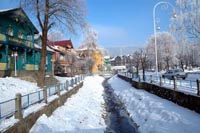In 1856, a second committee arrived to Krynica, revoking all previous orders and directives which ruined the health resort. The commission was headed by prof. Józef Dietl, now considered a reviver of the bankrupt town. He was a professor at the Jagiellonian University and the father of Polish balneology. In 1858 the mud bath treatment was introduced in Krynica. The commission issued a special report containing twelve specific demands, some of which remain valid to the present day (eg. introduction of a special local tax providing means for town development). It was at that time when building of the Old Bathrooms (designed by Felix Księżarski) was initiated. Significant investments were also done to extend the existing infrastructure. In 1857, the spa resort possessed 57 visitor rooms and 28 bathrooms, while till 1875 these numbers increased to 669 and 74, respectively, and were still quickly increasing. Accommodation was apparently still insufficient and many guests had to rent lodgings in the peasants’ houses.
In 1857, the post of senior physician was offered to dr. Wladyslaw Zieleniewski, an ambitious and enterprising man. Under his guidance Krynica become the leading spa in Galicia. One of his achievements was the opening of a Dietary Centre in the mansion “Witoldówka” in 1889. Significant donations from the Emperor allocated for the development of the spa allowed building of the Old Bathrooms, which was at that time the largest and most modern of its kind in Galicia. The range of therapeutic treatment on offer was broadened. In addition to tub, shower, ferruginous, mud, balsamic and gas baths which gradually became available, various sorts of inhalations, climatic and pneumatic treatments and electrical therapy could also be applied. “Slavic Steam Bathrooms” and River Swimming Center were opened. One of the local healing methods included “Żentyca”, a drink containing spring mineral water, wine and sugar or honey mixed in appropriate proportions. In 1860 a very popular pharmacy owned for many years by Hugo Nitribbita was opened in the mansion "Pod Krakowiakiem". The pharmacy offered a largest selection of mineral waters from home and abroad, as well as useful ointments and other medical remedies. Its speciality was the balsamic oil made from conifer sprouts and the so-called “Mineral Kołaczyki” (a kind of cakes).
With time, Krynica acquired a very unique atmosphere that boosted its intellectual and artistic life. Throughout the season, the orchestra entertained the spa visitors, since 1878 in a specially built pavilion which was later named “The Concert Shell”. Starting from 1868, the actors of the Krakow Theater came here to entertain the local audience with their performances (the Krynica Theatre erected in the years 1882 – 1883 was initially built for this purpose). In addition, many private houses arranged tea meetings, evening parties and balls, and the funds gained in this way were spent for necessary investment in the spa resort. Tours to the surrounding towns were also a popular pastime. The most frequented places included ruins of the Lubovna and Muszyna Castels, the Jaworzyna Hill, the famous "Devil's Stone", as well as other fashionable health resorts (Bardejov, Szczawnica or Żegiestow).
The year 1876 brought great changes for Galicia Province: the Emperor Franz Joseph ordered the construction of 750 km long railway track, from Galician Czadca through Zywiec, Sucha Beskidzka, Chabówka, Nowy Sacz, Jaslo, Krosno, Sanok and Stanislawów up to Husiatyn near the Russian border. The shorter auxiliary lines tied Muszyna and Tarnow. From that moment, the visitors had to use horse carriages only for the10 km distance from the railway station in the former capital of the Muszyna State to Krynica spa resort. Construction of a comfortable, beaten road to the town centre in 1878 made the spa resort even more available to the outer world. The County Council and (in the years 1855-1890) the seat of the District Court were moved here. It was also a place of famous fairs which were held here regularly. The last investment made in the 19th century was the water supply system for the town in 1900.
Popularity of Krynica abroad was also growing. In 1881, the town was awarded a silver medal at the Balneological Exhibition in Frankfurt. At that time, 18 mineral springs were exploited here. In the following years, new, modern bathrooms, a modern spa house and the railway line to Muszyna were built, and sanitary conditions were greatly improved. However, a major problem was the insufficient supply of mineral water for bathing, and a lack of surgical rooms, which forced patients to wait for a surgery up to several days. New mineral springs were continually searched for. Fortunately for Krynica, the head of the Hydrotherapy Centre of Krynica in 1884 became dr. Henry Ebers, a highly regarded physician educated at Krakow, Vienna and Paris universities.
At the end of the nineteenth century Krynica was a fashionable health resort and a meeting place for many famous Poles. Jan Matejko, A. Grottger, H. Sienkiewicz, J.I.Kraszewski and many others were frequent guests here. In the subsequent years and in the interwar period the resort was also visited by L. Solski, H. Modrzejewska, W. Reymont, J. Tuwim, K.I.Gałczyński and J. Kiepura (who had his own mansion "Patria" here). In the Theater Modrzewiowy (destroyed by fire in 1943) performed L. Solski and H. Modrzejewska.






